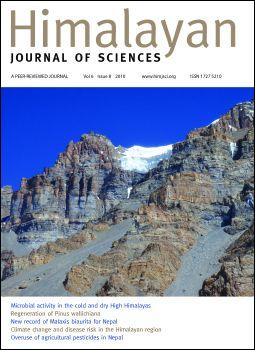Regeneration of <i>Pinus wallichiana</i> AB Jackson in a trans-Himalayan dry valley of north-central Nepal
DOI:
https://doi.org/10.3126/hjs.v6i8.1798Keywords:
density-diameter curve, regeneration, seedling, sapling, altitude, canopy, Manang ValleyAbstract
We studied the elevational pattern of forest composition and regeneration of the subalpine conifer tree species Pinus wallichiana in Manang, a trans-Himalayan dry valley in north-central Nepal. Thirty-five quadrats (10 m × 10 m) were laid between 3300 and 4000 masl on both north- and south-facing slopes. We measured diameter at breast height (DBH) of each mature individual of all tree species (DBH ≥10 cm), and recorded the number of seedlings (DBH <10 cm, height <30 cm) and saplings (DBH <10 cm, height >30 cm). We also measured soil moisture and soil pH, estimated canopy cover, and recorded slope and altitude in each quadrat. For all species together and for several species individually, tree density, seedling density, sapling density and tree basal area were found to decrease with elevation on both north and south aspects. This trend is largely explained by the progressively harsher environment at higher elevations. The north-facing slopes in our study area have denser forests than the south-facing slopes, the density of all size classes (seedling, sapling and mature plants) and basal area being greater on the northern aspects. These aspect-wide differences are attributable to the stark difference in soil moisture between northern and southern aspects, which is in turn due to the difference in insolation. Irrespective of elevation and aspect, all the forests studied are regenerating, as indicated by inverse J-shaped density-diameter curves. The elevational pattern of seedling and sapling abundance is explained only by elevation. Whereas other variables (e.g., canopy) are considered to have an important influence on seed germination and seedling establishment, they turn out not to be significant predictors of density of seedlings and saplings. This failure to identify a relationship is probably due to our use of non-parametric test (tree regression analysis) that we used to establish the relationship between density and its potential explanatory variables or due to our selection of 1 standard error rule yielding sub-optimal models for regression trees.
Key words: density-diameter curve; regeneration; seedling; sapling; altitude; canopy; Manang Valley
DOI: http://dx.doi.org/10.3126/hjs.v6i8.1798
Himalayan Journal of Sciences Vol.6 Issue 8 2010 pp.19-26




